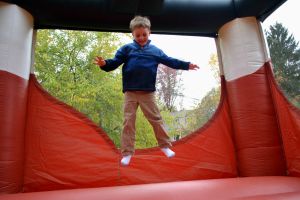A new study by researchers at the Center for Injury Research and Policy of The Research Institute at Nationwide Children’s Hospital examined pediatric injuries associated with inflatable bouncers, such as bounce houses and moonwalks. Researchers found that from 1995 to 2010 there was a 15-fold increase in the number of inflatable bouncer-related injuries that were treated in U.S. emergency departments among children younger than 18 years of age. In 2010 alone, more than 30 children per day, or about one child every 45 minutes, were treated in hospital emergency departments for injuries associated with inflatable bouncers.
The study, available online November 26, 2012 and published in the December 2012 print issue of Pediatrics, found that while fractures (28 percent) and strains or sprains (27 percent) were the most common types of injuries, approximately 1 in 5 injuries (19 percent) were to the head and neck, demonstrating that use of these products can pose serious risks. Falls (43 percent) were the most common cause of injury followed by stunts and collisions. The majority of the injuries occurred either in a recreational setting (44 percent) or at home (38 percent).
“The findings from this study show that there has been an alarming increase in the number of injuries from inflatable bouncers,” said Gary A. Smith, MD, DrPH director of the Center for Injury Research and Policy at Nationwide Children’s Hospital. “It is time for us to take action to prevent these injuries. Ensuring that parents are aware of the potential risks, improving surveillance of the injuries, developing national safety guidelines and improving bouncer design are the first steps.”
The study authors point out that the injury patterns for inflatable bouncers and trampolines are very similar, and although there are national safety guidelines for trampoline use, no such guidelines exist for inflatable bouncers.
“The medical and public health community has yet to provide recommendations on the safe use of inflatable bouncers,” said Dr. Smith, also a professor of Pediatrics at The Ohio State University College of Medicine. “The growing epidemic of inflatable bouncer injuries make it clear that it is time to do so.”
Until national safety guidelines are in place, parents should consider the risks before allowing their child to use an inflatable bouncer. If parents allow their child to use an inflatable bouncer, they should consider limiting use to children 6 years of age and older, requiring that an adult be present to supervise while the bouncer is in use and allowing only one child on the bouncer at a time. If more than one child will be on the bouncer at the same time, the children should be approximately of the same age and size.
This is the first study to use a nationally representative sample to examine injuries associated with inflatable bouncer-related injuries that were treated in U.S. emergency departments. Data for this study were obtained from the National Electronic Injury Surveillance System (NEISS), which is operated by the U.S. Consumer Product Safety Commission. The NEISS provides information on consumer product-related and sports and recreation-related injuries treated in hospital emergency departments across the country.
The Center for Injury Research and Policy (CIRP) of The Research Institute at Nationwide Children’s Hospital works globally to reduce injury-related pediatric death and disabilities. With innovative research at its core, CIRP works to continually improve the scientific understanding of the epidemiology, biomechanics, prevention, acute treatment and rehabilitation of injuries. CIRP serves as a pioneer by translating cutting edge injury research into education, policy, and advances in clinical care. For related injury prevention materials or to learn more about CIRP, visit http://www.injurycenter.org.

Dr. Smith recommends that an adult be present to supervise while the bouncer is in use and to allow only one child on the bouncer at a time. View and download high resolution photo.
Learn more about injury prevention tips and proper use of inflatable bouncers.
